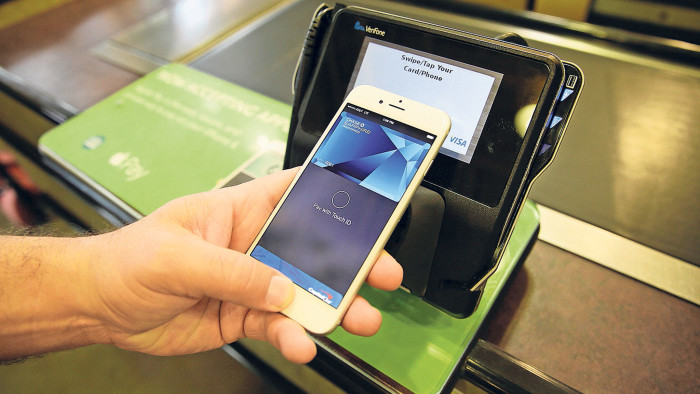Progress in store for mobile payment systems

Simply sign up to the Technology sector myFT Digest -- delivered directly to your inbox.
For years, the story has been that mobile is finally about to take flight and fulfil all its potential — in the process bringing wealth to a new set of entrepreneurs, inventors and investors.
Mobile payments, for example, have long been hailed as the next big thing, but this year retail and payment industry leaders say that — finally — 2015 is going to be different.
“Every year since about 2009 has been the tipping point year for mobile payments,” says David Hodgkinson, a consultant at KPMG in London, but he adds: “If I’m really honest, the quantified market projections vary wildly, and they’re fairly meaningless.”
Yet he and others say developments indicate that 2015 will be — if not a breakthrough year — then at least a year of substantial progress. The factors behind this are the launch of Apple Pay, the efforts by ecommerce companies to give consumers better ways to buy goods with mobile devices, and the realisation by banks that they will lose out if they do not focus on the technology.
The key event, says nearly everyone in the industry, was the launch last year of Apple Pay. This feature allows users to store their credit or debit card information on their iPhone and then either tap the phone on a special receiver to pay for goods in a shop or buy online with one click while shopping on an app that uses the service.
Apple is not the first to make a so-called mobile wallet. US telecoms tried a similar wallet named Isis, later rebranded as Softcard. Google had Google Wallet. Square, a start-up led by Jack Dorsey, a founder of Twitter, which makes credit card readers and small business software, also tried a similar product. None were popular. The interfaces could be clunky, and too few retailers accepted the wallets to get consumers using them regularly.
But Apple is Apple. The design of Apple Pay has been widely hailed and well reviewed. More crucially, Apple partnered with nearly all the leading US banks, as well as many big retailers and app makers, thereby ensuring that the vast majority of iPhone 6 users in the US can store their cards with Apple Pay and regularly find places that take them.
Apple’s push into payments has helped drive the development of secure technology to store cards on phones. Visa, MasterCard and others use the technology and say it is highly secure against theft and fraud, although its defences have yet to be tested. Few card details will be handled by the retailer so, as it is bugs in retailers’ in-house software that often allow hackers to steal card data, this represents an improvement for consumers.
For in-store payments, the requirement of a fingerprint will also cut down on “friendly fire” fraud — when customers fraudulently report their cards have been stolen and someone else has used them to purchase goods, says one person in the industry. For the financial institutions that issue credit, however, the rise of smartphone-enabled payments has risks.
Banks profit when consumers use their cards, but as consumers store multiple accounts on their phones it is possible that the brand identity associated with each bank could weaken.
As networks such as Apple Pay capture more of the market, they could also raise the portion of the profit on each transaction they take, or otherwise stop using banks or existing parts of the chain of companies that currently handle card payments.
Doug Brown, who works on ebanking and mobile at FIS, a banking and payments technology company, says: “This is the defining moment for [financial services groups], for their brand identity and relevance.
“If all the value is managed by an oligopoly, whether that’s Apple, Samsung, or a payment network, and at the end of the day everything accrues value to only a few entities, then for the thousands of financial institutions that we work with, that would be a fail.”
There is still a best case, he says. Some banks are working to integrate payment capabilities into their own apps, so consumers could use those to pay rather than Apple’s app. To make their apps more useful, some banks are also installing systems on ATMs that allow customers to use their smartphone to withdraw cash without a card.
Even if Apple Pay leads the market, others will still have a chance, analysts say. Speciality wallets could still serve a niche, such as ones that store bitcoins, or credits for video games or ones that are linked to and give rewards at a particular store such as Starbucks, which already has one of the more successful mobile payment apps.
Regulators in the US and Europe are also likely to ensure that Apple keeps its platform open so that other mobile wallets can operate on its iOS mobile operating system, says Mark Thompson, a partner at law firm Sidley Austin.
“My expectation is Apple cannot just say ‘we’ll only allow this payment app on our phone’, they will eventually allow other wallets [to use the platform],” says Mr Thompson.
However, he adds, just because Apple cannot be anti-competitive and keep others from using its phones, this does not mean those competitors will be successful.
Comments